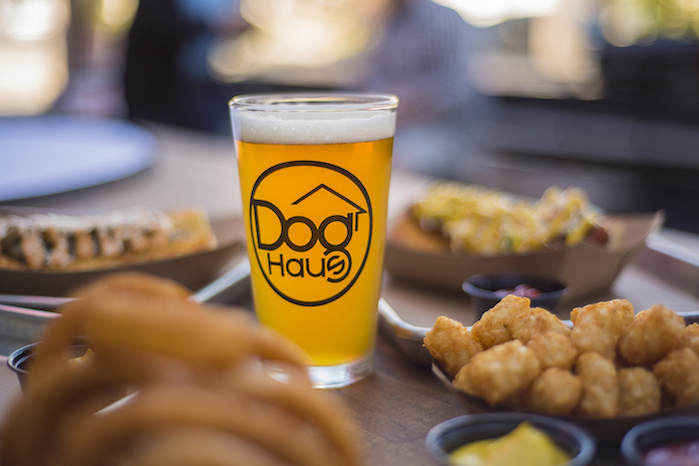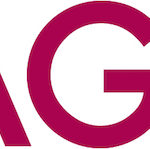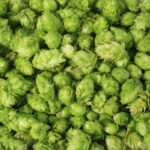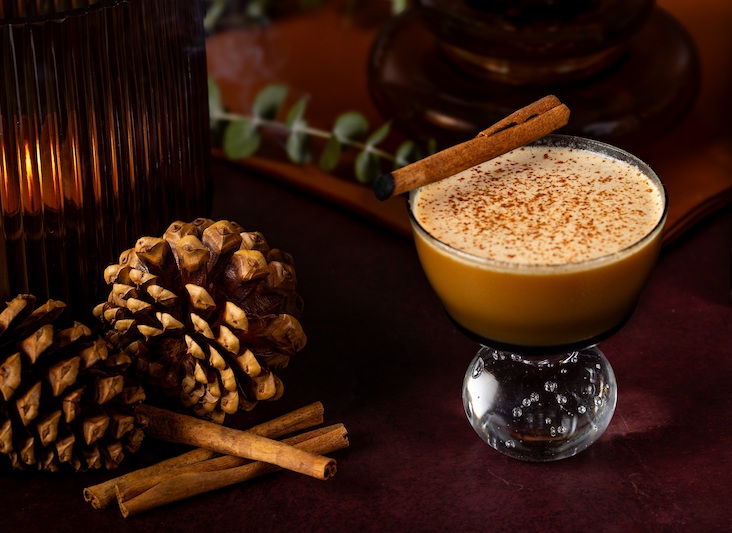Dog Haus has been dishing out gourmet hot dogs and sausages since the first location opened in 2010. The Pasadena, CA-based chain specializing in “the absolute wurst” is now up to 25 locations in six states; mostly in Southern California, along with Utah, Colorado, Texas and Illinois.
Several Dog Haus restaurants are set to open early this year, including the first East Coast location in Bethesda, MD. Plans are in place for rapid expansion through franchising: Dog Haus will open about 450 new franchises across the country in the next six years.
What’s driving growth for a concept based on the humble hot dog? The popular fast-casual dining trend and continued consumer interest in craft beer.
When it comes to brews, “We want to have something for everyone,” says Dog Haus cofounder Quasim Riaz, who started the chain with partners Hagop Giragossian and André Vener. “We have a very well-curated beer list.”
Every Dog Haus location has at least 24 taps and an approved list of styles and beers. Those styles are spread out proportionately among the available taps, and provide a beer selection for every palate, Riaz says.
Unless that palate is hankering for an imported or big macro brand: Dog Haus pours only beers made in the U.S. and focuses on regional craft brews. But staffers will help guests find a beer that they’ll enjoy from the restaurants’ vast selection.

What’s driving growth for a concept based on the humble hot dog? The popular fast-casual dining trend and continued consumer interest in craft beer.
Local flavor

“We have a very well-curated beer list,” says Dog Haus cofounder Quasim Riaz, who started the chain with partners Hagop Giragossian and André Vener. “We want to have something for everyone.”
Each Dog Haus restaurant aims to offer guests the best brews from the region.
Since the three founders are craft fans, they approach their beer selection from the viewpoint of a microbrew aficionado.
“I want different beers on different days,” says Riaz. “If it’s a cold-weather day, then I’m happy to see an Old Rasputin Nitro Stout [from North Coast Brewing Co.] on tap. What I don’t like is the place with only one beer style, which typically means only IPAs or hoppier beers.”
While Dog Haus naturally offers several IPAs—it is the most popular craft style, after all—Riaz also places emphasis on having a handful of easy-drinkers that are clean and crisp but not too light.
These include kölsches, helles lagers and certain pilsners. Victory Prima Pils, for instance, a German Pilsener style beer brewed by Victory Brewing Co. in Downingtown, PA, is more balanced than light, with a smooth blend of malts and hops that help wash down a gourmet hot dog.
From there, the list of approved styles moves on to malt-forward beers, red ales, pale ales and the hoppier IPAs. Riaz cites the Zombie Dust pale ale from Munster, IN-based 3 Floyds Brewing Co. as a personal favorite for its balanced flavors.
Dark beers come next: stouts, porters and what so many places serving craft beer severely lack—nutty brown ales.
Fine-tuning the Beer Selections
Dog Haus franchisees are usually craft beer fans themselves.While they may initially need some hands-on help in selecting brews, they eventually earn the trust of Riaz and his team. After all, a Dog Haus franchisee will know the local beer scene better than the folks back at corporate.
Franchisees submit local beers to corporate for approval. The longer the relationship between a franchise and the founders, the greater leeway given in approvals.
The approval process helps prevent duds from clogging up tap lines. “Where people get in trouble is with stuff like habanero-chili-spiced beers,” Riaz says. “Good luck getting through an entire keg of that. We try not to do crazy beers.”
The chain will stock slower-moving styles if they’re a fit. While Riaz is a fan of sour beers, he admits that they’re an acquired taste, and may also sit on tap lines for longer than desired.
The individual operators reach out and form the critical relationships with local breweries, which helps Dog Haus maintain the atmosphere of a community hall. “We want each location to feel like it’s part of the community,” Riaz says, “and we reinforce that by serving a lot of the local beer that that community likes to drink.”
The approved list of styles also makes it easier for locations to manage their tap lines and change kegs quickly. “When, say, tap #7 kicks, you never have to guess what style goes on next,” says Riaz, “because you have a list that says, ‘Here’s 30 beers that are approved for that tap handle.” Pairing premium dogs
In addition to its signature all-beef dogs and handcrafted sausages, the Dog Haus menu offers 100% Black Angus beef burgers, sliders, fried chicken sandwiches and chili. Sides include French fries, onion rings, tater tots and cole slaw.
The Freiburger, named after the city Freiburg in Germany, offers a little of everything: a beef patty with white American cheese, fried egg, “haus” slaw, fries and mayonnaise. All dogs, sausages, burgers and chicken sandwiches are served on grilled King’s Hawaiian rolls.
Pairing such fare with beers comes natural, Riaz says. The carbonated qualities of beer scrub the palate clean between bites of food.

Pairing Dog Haus fare with beers comes natural, Riaz says. The carbonated qualities of beer scrub the palate clean between bites of food.
To match brews with what’s on the menu, you can compare and contrast, Riaz says. For example, a spicier sausage goes naturally with the hoppier, more-bitter IPAs, which meet the dish in intensity.
So, too, do foreign styles of sausage and brews match. A German bratwurst pairs well with the mildly malty, well-balanced beer styles common from that country.
Then there’s contrasting: drinking a rich, crisp beer that can cut through the fat of a burger.
Certain pairings are always a home run, Riaz says. For instance, he recommends a saison beer with Dog Haus Sooo Cali dog (with wild arugula, spicy basil aioli, crispy onions, avocado and tomato) “as it would bring out some crisp bitterness in the arugula.”
Or, he adds, “if someone was looking to intensify the spiciness of the basil aioli, they could try an IPA.”
The menu does not recommend specific pairings due to limited space. So that task falls to the staff, who are trained on which beers to recommend for different food orders.
Tapping into Freshness
Dog Haus typically stocks no more than four to six beers in bottles or cans at any given location, and typically just cans. This enables Dog Haus to carry some larger-scale staples that might not normally make the tap line.
For instance, the Colorado location stocks cans of New Belgium Fat Tire Amber Ale, a ubiquitous beer in the state. If a customer wants a PBR, they might discover that a Dog Haus location keeps a palate of it in the cooler.
But Dog Haus relies on beers that are fresh, local and popular. And the best way to pour those smaller-batch, trendy brews is to get them on tap.
Some stores count 30 taps, but Riaz believes that 24 is the perfect number. It allows for the right amount of variety among beers, without leading customers towards paralysis by analysis.
There is such a thing as too many tap handles, Riaz says. “I’ve seen places with 100. That means the beer is not getting drank fast enough. It sits on the line and gets old. Beer needs to be fresh.”
That’s in part why Riaz doesn’t recommend that Dog Haus owners engage in tap takeovers and brewery tastings. It’s fun for that one night when a single producer puts beers on 14 out of 24 taps. But on days that follow, a number of those beers may sit on the line and reduce options for customers who may prefer more parity.

Some stores count 30 taps, but Riaz believes that 24 is the perfect number. It allows for the right amount of variety among beers, without leading customers towards paralysis by analysis.
Keeping Cool
Riaz says that 38 degrees Fahrenheit is the ideal temp for the keg coolers. When brews get too cold, you cannot fully taste their flavors. And you definitely don’t want to serve beer too warm.
Dog Haus locations use long-draw draft systems. Unlike direct draw, in which a faucet pours beer straight up from the keg below, with long draw the kegs are stored 50 to 100 feet away from the tap.
That means you have more space behind the bar and it’s easier to change the kegs in a remote back room.
To ensure that beer keeps its chill during the trip through the long plastic tubes from the keg to the tap, the tubes of the long-draw systems are insulated within an outer, separate layer. Inside this secondary layer, a system circulates cool glycol fluid along and around the tubes, which keeps the traveling beer chilled within the inner channel.
It’s not cheap to set up a professional long-draw system with glycol. Additional costs range from $4,000 to $10,000, depending on the number of taps and the distance travelled between the cooler and the taps, Riaz says.
But he believes the outcome is worth the higher cost for the advantages it provides. Besides separating the kegs from the bar, a properly chilled long-draw system also allows for more variety among beers offered.
“Not all logs are sixth barrel” standard measurement, Riaz explains. “Some come in half kegs and other sizes. If you have a big list of beer like us, you need the room for all those differently sized kegs.”

Dog Haus locations use long-draw draft systems. Unlike direct draw, in which a faucet pours beer straight up from the keg below, with long draw the kegs are stored 50 to 100 feet away from the tap.
Educating Customers
Because Dog Haus doesn’t carry the big macro brands, a bit of polite education can go a long way. No guest likes to hear that they are a simpleton or philistine for ordering what they want to drink. That is not a recipe for a repeat customer.
Talking down to customers with low craft experience is never the correct course of action. Riaz reminds his franchisees that they are in the hospitality business. Dog Haus exists to serve and guide its guests—not preach to people.
“If someone comes in and asks for Coors Light, we’ll explain that we don’t carry that, but perhaps that customer would like to try a helles lager,” says Riaz. “Or if they like New Castle, then perhaps they’d like this craft brown ale. We say, ‘Try this instead and let me know what you think’.”
“Educating these customers that we have something like those craft beers for them is better than simply saying we don’t carry Coors,” he adds.
Attention to Detail
Dog Haus staffers undergo training so that they can point consumers in the right direction with beers, and serve these products correctly. This covers a range of techniques, often correcting poor behaviors learned at prior jobs.
For instance, some bartenders don’t look at the beer glass when they pour it, or they allow parts of the tap handle to submerge in the beer while pouring. That’s unsanitary, and a mark of not paying attention to the right details.
“We have to untrain a lot of bartenders,” Riaz says. “There is a tremendous amount of waste that happens from lack of bartender education when pouring beer, so at Dog Haus we put a great emphasis on ensuring our bar staff are well trained and know how to pour a beer well.”
Beer Today
For all its focus on local, fresh and popular, Riaz does not concern himself greatly with beer trends or specific seasonal brews. Rather, having the perfect variety of options at each location and beers that match the general weather of the season is how he envisions the Dog Haus selection.
“I think many people have realized that the best beer is whatever you’re in the mood that day to drink,” he notes.
Kyle Swartz is managing editor of Cheers magazine. Reach him at kswartz@epgmediallc.com or on Twitter @kswartzz. Read his recent piece 11 Craft Beer Trends in 2018.









